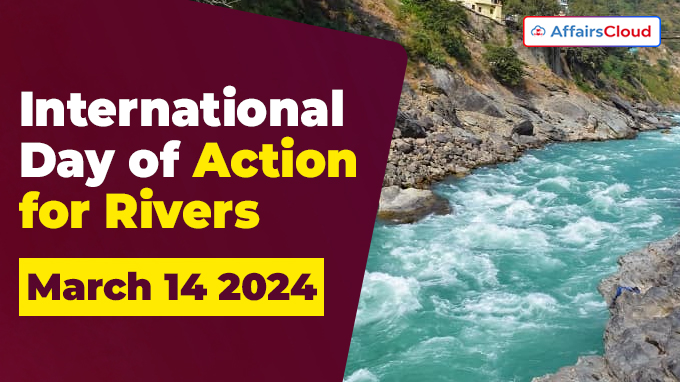 The International Day of Action for Rivers is annually observed across the globe on 14 March to raise awareness about the importance of rivers and advocate for their protection and preservation. The day aims to draw attention to the threats faced by the rivers.
The International Day of Action for Rivers is annually observed across the globe on 14 March to raise awareness about the importance of rivers and advocate for their protection and preservation. The day aims to draw attention to the threats faced by the rivers.
14 March 2024 marks the celebration of the 27th anniversary of the International Day of Action for Rivers.
- The 2024 theme of International Day of Action for Rivers is, “Water for All.”
Note: The Day was previously known as International Day of Action Against Dams and For Rivers, Water and Life.
Objectives:
i.To highlight the significance of rivers in our lives;
ii.To raise awareness about the way freshwater ecosystems like rivers are increasingly being polluted due to human activities;
iii.To promote and safeguard equitable access to clean and flowing water.
Background:
i.The International Day of Action Against Dams and For Rivers, Water and Life was adopted by the participants of the 1st International Meeting of People Affected by Dams in March 1997 in Curitiba Brazil.
- The idea for the 1st International Meeting of People Affected by Dams originated during an annual meeting of Brazil’s Movement of People Affected by Large Dams (MAB).
ii.Representatives from 20 countries proclaimed that the International Day of Action would take place on March 14, coinciding with Brazil’s Day of Action Against Large Dams.
iii.The 1st International Day of Action for Rivers was observed on 14 March 1998.
Note: The 20 countries include Taiwan, Brazil, Chile, Lesotho, Argentina, Thailand, Russia, France, Switzerland, and the United States of America (USA).
Threats to Rivers:
i.Pollution from industrial waste, agricultural runoff, and plastic waste endangers river ecosystems.
ii.Dam construction disrupts natural river flow and habitats.
iii.Deforestation and urbanisation contribute to erosion and sedimentation.
iv.Climate changes such as rising temperatures, more frequent extreme storms, and changes in season precipitation rates will impact lakes, rivers, and streams.
Actions to Protect Rivers:
i.Implementing strict environmental regulations to reduce pollution.
ii.Promoting sustainable practices in agriculture and industry.
iii.Restoring river ecosystems through habitat rehabilitation and reforestation projects.
Key Facts:
i.Since 1970, freshwater species have experienced an 83% decline, highlighting the urgent need for collective action to protect these invaluable resources.
ii.Globally, over 2 million tons of sewage and industrial and agricultural waste are discharged into the rivers every day.
- It is equivalent to the total weight of the entire 7.2 billion human population.
iii.Scientists estimate that all the rivers in the world carry about 3.6 billion metric tons (4 billion tons) of salt from land to the ocean each year.
iv.According to the World Wildlife Fund (WWF),
- Rivers provide drinking water for about 2 billion people globally; and
- 500 million people (approximately 1 in 14 people on Earth) live on deltas that are sustained by sediment from rivers.
About International Rivers:
Interim Co-Executive Directors– Josh Klemm and Isabella Winkler
Headquarters– Oakland, USA
Formed in– 1985




